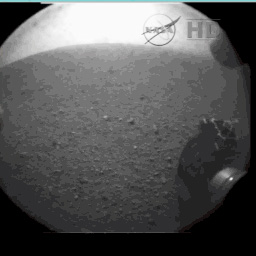 This is a way geeky night for us engineers, and somewhat akin to the 1969 moon landing in many ways. I’m watching the Mars rover Curiosity landing right now (14 minutes delayed, of course, due to the speed of light). “Parachute deploy!” they say just now. And a minute or two later I’m watching as the JPL engineers report “Touchdown confirmed, we are safe on Mars … and … Now to see where Curiosity will take us.” The largest rover and science experiment to date has landed on Mars (afternoon Mars time, actually). By the time the radio signals reached us, the rover had been there for 14 minutes. (The photo is of a wheel cover, which I guess a mechanic is going to remove tomorrow.) Follow developments online at nasa.gov/msl
This is a way geeky night for us engineers, and somewhat akin to the 1969 moon landing in many ways. I’m watching the Mars rover Curiosity landing right now (14 minutes delayed, of course, due to the speed of light). “Parachute deploy!” they say just now. And a minute or two later I’m watching as the JPL engineers report “Touchdown confirmed, we are safe on Mars … and … Now to see where Curiosity will take us.” The largest rover and science experiment to date has landed on Mars (afternoon Mars time, actually). By the time the radio signals reached us, the rover had been there for 14 minutes. (The photo is of a wheel cover, which I guess a mechanic is going to remove tomorrow.) Follow developments online at nasa.gov/msl
As the craft was descending into the Martian atmosphere, one of the engineers reported it was drawing 300mA of current. That’s the same current my FT-817 radio draws when receiving (let alone transmitting, as Curiosity was). Hardly anything at all. And later they reported just over 2000mA while transmitting and landing (at 32V). About the same power as a 60W bulb. The signals that were going out from the spacecraft were a bit stronger than those I put out when I’m on the air (but not much), and yet they were traversing 156 million miles (if my math is right – based on 14 seconds and the speed of light) before being received here on Earth, and the data was coming through just fine. Of course, we’re also talking extremely high-gain antennas here on earth (Canberra and Goldstone—the deep space network).
Also, the idea that these signals could bring telemetry data with them — those first 64×64 photos, then 256×256 photos of the craft’s wheel on the Martian surface, was quite striking. The bit rates were way low, and yet data was coming through on those weak signals. Then the first photo, of one wheel of the most recent object from Earth to reach Mars. What’s more, the signals were being relayed through another satellite, so the whole process was even sketchier. Xeni Jardin’s question about what data-compression method was used to transmit the photo was fun, but probably irrelevant for a 64 x 64 photo (probably 32k bits altogether).
So why do I say this affected my radio operations? It’s because I’m now motivated to dive even more into data transmission and automated operations. And especially radio communications that can function well under adverse conditions.
In the words of White House Science and Technology Advisor John Holdren, “Long live American curiosity.” And I would add, all curiosity.
funny, I had the same reaction re mars landing being like the moon mission of 1969! For that, I was in the master control room at ABC TV news. We were getting the feeds from NASA before any other network. It was up to our unit, the Special Events unit which I had been a part of until the year before (my past alliance gave me privilege), that made the feed available to the rest of the world. It was about as an exciting time as it gets in the world of broadcasting for which my life seems ordained, given KidCast for Peace was the first ever multinode many-to-many video broadcast on the Internet that enabled children in countries of conflict to “be” with each other (June 24, 1995) despite geographic and language barriers.